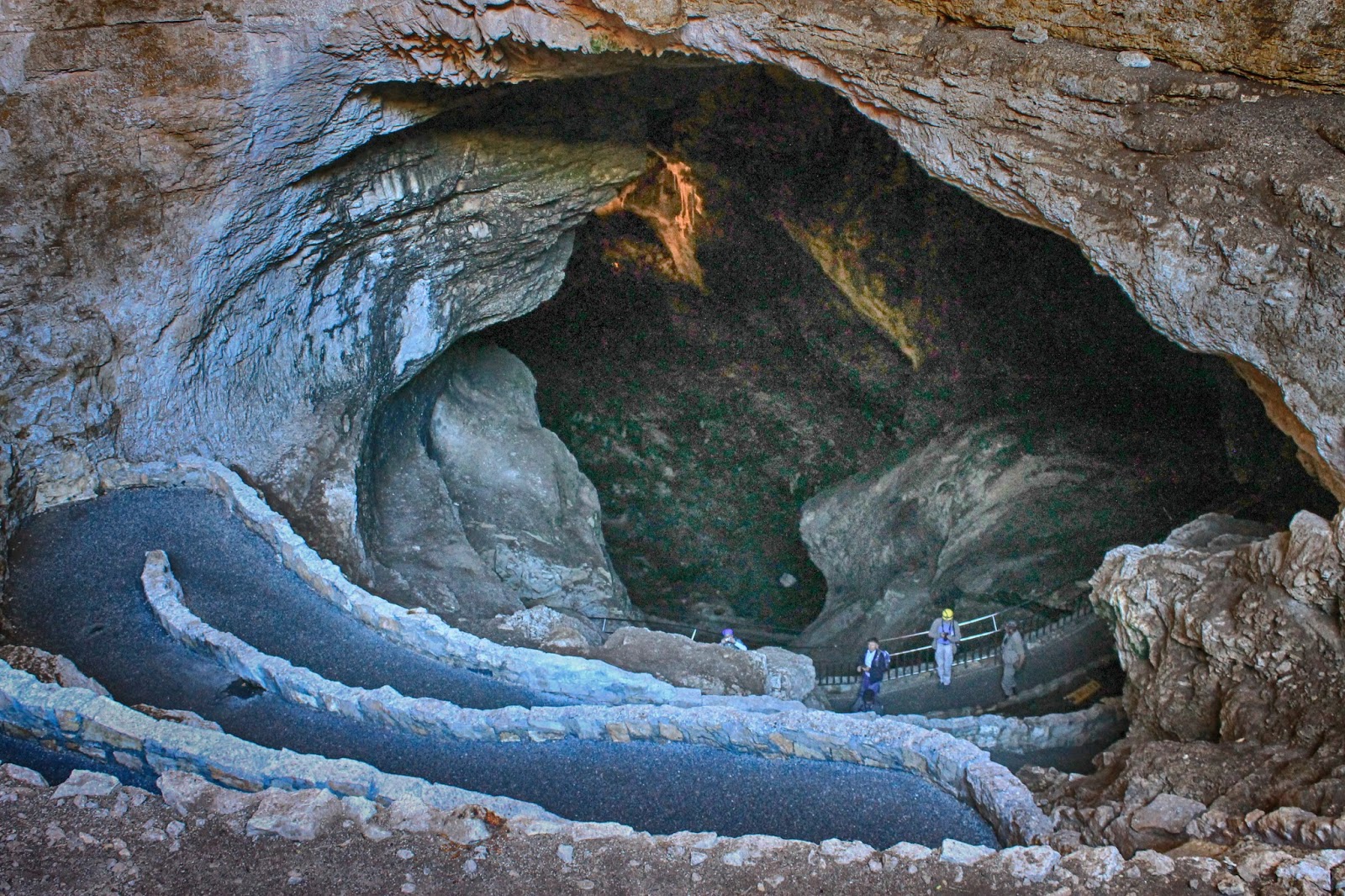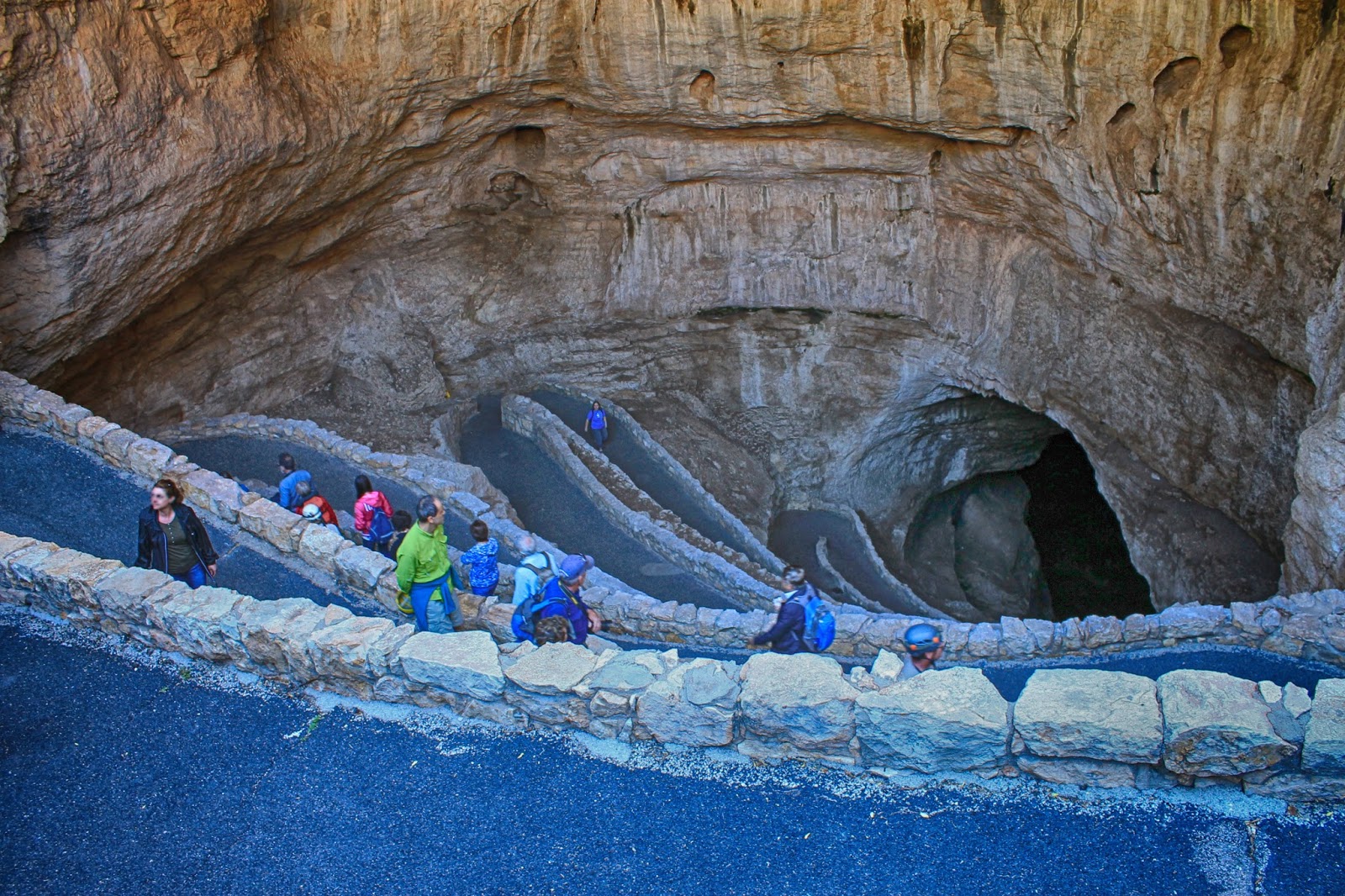The “Road To Hell in Carlsbad Caverns National Park, New Mexico
Travel to Carlsbad Caverns National Park in southern New Mexico, and you’ll arrive at a landscape with more than 100 caves, have the opportunity to witness thousands of bats take flight into the Chihuahuan Desert, marvel at the beauty of ancient sea ledges and acid-dissolved limestone, and walk down what’s been called “the road to hell.”
When approaching the main cave, visitors are met by a steep and winding trail that descends into the main cavern. As you walk down the trail, the cavern seems to swallow the daylight, hence the nickname “road to hell.” For those who prefer to walk the “righteous path,” the park’s surface landscape is also home to flowering cactus and desert wildlife within the beautiful, canyon-cut desert of Carlsbad, New Mexico.

Getting Around Carlsbad Caverns National Park
Carlsbad Caverns National Park is located near Carlsbad, New Mexico, and can be reached via U.S. Highways 62 and 180. It is about 18 miles southwest of Carlsbad, New Mexico. The driving distance is 149 miles east of El Paso, Texas. There is only one entrance road to the park, the Carlsbad Caverns Highway.
Carlsbad is served by Greyhound and TNM&O bus lines. Major airlines serve Roswell and Albuquerque, New Mexico, and El Paso, Lubbock, and Midland, Texas. Rental cars and taxi service are available from the airport in Carlsbad.
Park History
Carlsbad Caverns holds a history that dates back to the prehistoric era and is one of 300 limestone caves in the southeastern corner of New Mexico, not far from the Texas border. Now, while this doesn’t necessarily mean dinosaurs walked the caverns, the Permian Reef certainly was home to interesting creatures. These caves were created within a fossil reef laid down by an inland sea that existed about 250 to 280 million years ago.
The caverns contain unique examples of marine fossils that date back to the Permian period; these fossils are found within the limestone formation. Among the fossils found here are sponges, moss animals, rare horn coral, nautiloids, and snails.
In the 1400s, native cultures began exploring what is now Carlsbad’s sister park, Guadalupe Mountains National Park. A century later, Spanish explorers often ventured into parts of Carlsbad Caverns as well.
Spain claimed the Southwest until 1821, when Mexico revolted and claimed independence, according to the National Park Service. At the same time, Mexico was fighting the United States’ westward expansion but lost, giving way to the New Mexico Territory in 1850.

This created cultural conflict between the native peoples who had resided in the area for so long and the United States government. What is now Carlsbad was established in 1888, 24 years before New Mexico officially became a state.
Ray V. Davis photographed parts of the caverns in about 1915, sparking public interest in them after the New York Times published some of his work in 1923. This led to the caverns being surveyed and mapped months later, and on October 25, 1923, President Calvin Coolidge signed the legislation that established Carlsbad Cave National Monument.
The caves were extensively explored by Dr. Willis T. Lee and Jim White in 1924, and by 1925, a staircase was installed from the natural entrance to the Bat Cave, eliminating the use of a guano bucket to enter the caverns and marking the beginning of the road to hell.
As progress was continuously made to explore the caverns, dirt paths were created for the Main Corridor, Kings Palace, Queens Chamber, and parts of the Big Room. In addition, by 1926, an electric lighting system had been implemented for the Main Corridor and Kings Palace.
As renovations continued over the years, Congress redesignated the caverns at Carlsbad Caverns National Park in May 1930. By January 1932, the park’s 750-foot elevator was operating after about a year of construction. Two more elevators were added in the mid-1950s.
In December 1955, the caverns were declared a World Heritage Site by the United Nations Educational, Scientific, and Cultural Organization.
A Look Into The Caves
While the national park counts 119 different caves, only three are open to the public for tours: the famous Carlsbad Cavern, Slaughter Canyon Cave, and Spider Cave. However, Slaughter Canyon and Spider Cave are only available to explore with a guide. While Lechuguilla Cave is world-renowned, it is open only to researchers.
Unlike most caves, Carlsbad Caverns did not form simply via rainwater slowly dissolving limestone and eventually carving out cave systems. These caverns came to be about four to six million years ago when hydrogen-sulfide-rich waters began to migrate through fractures and faults in the Capitan limestone, according to the National Park Service. As this unique water mixed with rainwater and oxygen, it formed sulfuric acid that dissolved the limestone and formed the caverns (leaving behind huge gypsum deposits, clay, and silt).
Over time, deeper cave passages formed as the active level dropped, forming great cave formations that look much like they do today. Some of the most popular caves are Carlsbad Cavern and Lechuguilla Cave, which is more than 140 miles long. Lechugilla Cave is not open to the public due to its delicate formations; only permitted scientific expeditions are allowed. People continue to explore the caverns, pushing new routes and discovering their unique characteristics, such as speleothems, fungi, and the depths of the caves.
For quite some time, Lechuguilla Cave held no significance for the park. In the 1950s, cavers heard gusting wind on the floor of the cave, but it wasn’t until three decades later, in 1984, that cavers from Colorado gained Park Service permission to dig around to see if they could find a passageway. “The breakthrough into large walking passages occurred on May 26, 1986,” the park notes on its website. Through this process, this national park is now home to one of the longest caves in the world and the second-deepest limestone cave in the United States.
Other than its record size, Lechuguilla Cave revealed a variety of rare speleothems, which are structures formed from depositions in caves; some of these speleothems had never been seen anywhere. Other findings included an abundance of gypsum in the shapes of chandeliers, hairs, and beards; soda straws; hydromagnesite balloons; cave pearls; subaqueous helictites and rusticles; u-loops; j-loops; and lemon yellow sulfur deposits. This large amount of evidence became very exciting for scientific exploration.
While the Lechuguilla Cave is incredibly rich in speleothems compared to any other cave in the area, it does not contain a room larger than Carlsbad’s Big Room.
Other speleothems commonly found in the caverns include stalactites, draperies, ribbons, or curtains found on ceilings, while on the cave floor are totem poles, flowstone, rimstone dams, lily pads, shelves, cave pools, and stalagmites, according to the National Park Service.
Scientists believe that caverns may travel deep enough to study five different geologic formations, contain rare bacteria such as chemolithoautotrophic (rock eating), and might hold medicinal qualities that would benefit humans.
Threatening this incredible cave system are nearby lands managed by the U.S. Bureau of Land Management, where energy exploration could cause oils and gases to leak into the cave system, destroy the delicate ecosystem, and threaten people’s safety. However, the park closely oversees this in order to minimize this threat.
Visitors can explore the caverns through ranger-guided tours of Carlsbad Cavern, Slaughter Canyon Cave, and Spider Cave, while visitors with technical caving skills can participate in self-guided and ranger-guided tours to many caves with proper permits.
Related Post
A shocking documentary proves that mermaids do exist
SHOCKING Revelation: Thuya, Mother of Queen Tiye, Was the Grandmother of Akhenaten and Tutankhamun—What Ancient Egyptian Secrets Did She Leave Behind?
Breaking News: Astonishing Discoveries at Karahan Tepe Confirm an Extraterrestrial Civilization is Hiding on Earth, and NO ONE Knows!
Breaking News: Researchers FINALLY Discover U.S. Navy Flight 19 After 75 Years Lost in the Bermuda Triangle!
NASA’s Secret Investigation: Uncovering the Astonishing Mystery of the UFO Crash on the Mountain!
Explosive UFO Docs LEAKED: Startling Proof That Aliens Ruled Ancient Egypt!
